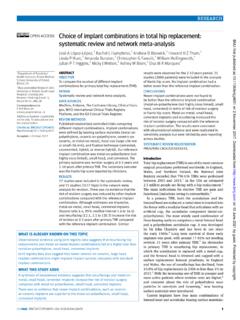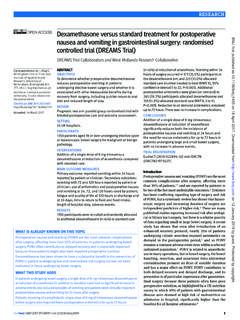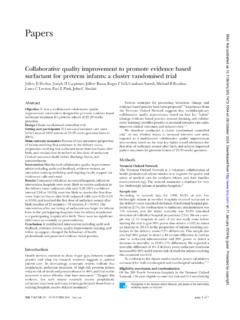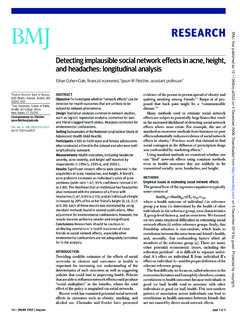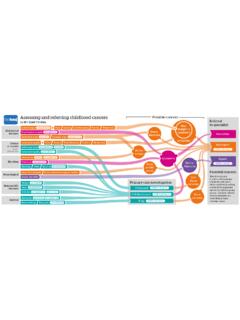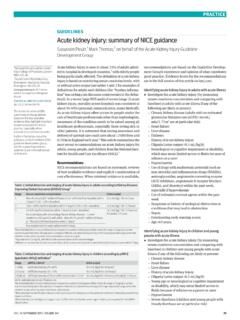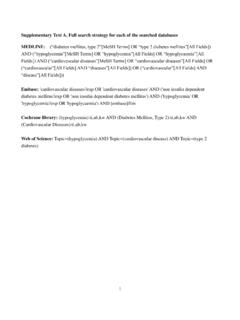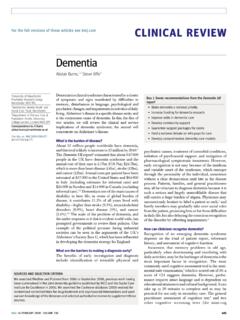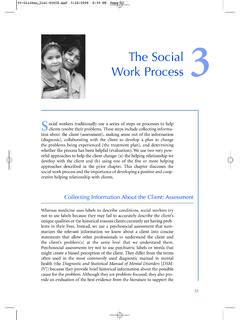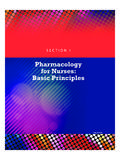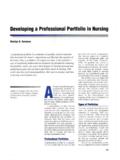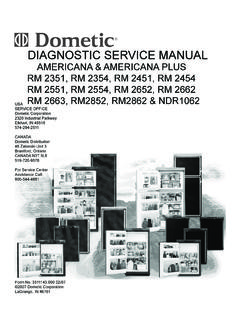Transcription of Errors in clinical reasoning: causes and remedial strategies
1 ANALYSIS. Errors in clinical reasoning: causes and remedial strategies Everyone makes mistakes, but greater awareness of the causes would help clinicians to avoid many of them, as Ian Scott explains Most Errors in clinical reasoning are not and clinicians' appreciation of the scale Box 1 | Commonly stated explanations for due to incompetence or inadequate knowl- and causes of the problem. For example, no decision Errors edge but to frailty of human thinking under more than 10% of clinicians admit, when conditions of complexity, uncertainty, and asked, to any error in diagnosis over the Errors in diagnosis pressure of time. To minimise such cogni- past year,10 and 40% of diagnoses about It (the correct diagnosis) never crossed my mind tive error we need to understand its preva- which clinicians were certain were proved I paid too much attention to one finding, lence and causes .
2 In this article I discuss why wrong at Clinicians often stay especially laboratory results Errors occur and describe strategies that may wedded to an incorrect diagnosis, even if I did not listen enough to the patient's story help avoid them. the correct one is suggested by colleagues I was in too much of a hurry or by decision support In terms of I didn't know enough about the disease Prevalence of reasoning error management, no correlation exists between I let the consultant or specialist convince me The first step to optimal care is making actual rates of guideline concordance and the correct diagnosis, which is missed or how closely clinicians perceive themselves I didn't reassess the situation when things didn't fit delayed in between 5% and 14% of acute as adhering to 14 Being an older hospital 2 Autopsy studies con- and presumably more experienced clinician The patient had too many problems at once firm diagnostic error rates of 10-20%,3 4 with also does not guarantee better quality carew1 I was overly influenced by a similar case autopsy disclosing previously undiagnosed or lower risk of reasoning I failed to convince the patient to have further problems in up to 25% of Even if the investigations diagnosis is correct.
3 Up to 45% of patients Cognitive psychology of clinical reasoning I was in denial of an upsetting diagnosis with acute or chronic medical conditions More research has focused on diagnostic rea- do not receive recommended evidence soning than on management (or treatment) Errors in management based care,5 while between 20% and 30% of reasoning,w3 but the cognitive psychology The treatment seemed to work well on the last administered investigations of both share common prop- patient who had the same problem and drugs are potentially Clinicians often stay erties. Diagnosis begins with Most of my colleagues were very keen on this Clinicians are wedded to an incorrect acquisition of data through new drug so I used it too sometimes less willing to diagnosis, even if the history taking and clinical I was too concerned about possible side effects adopt new beneficial inter- correct one is suggested examination.
4 Clinicians use and underestimated the potential benefit of ventions than to abandon old by colleagues or by these data, almost subcon- treating with drug x. ineffective decision support tools sciously, to frame or contex- I thought I should be seen to be doing The extent to which these tualise the patient's problem something, even though I knew the treatment deficits relate directly to reasoning error as a clinically meaningful representation. had little chance of success by clinicians, rather than environmen- They then use various semantic or abstract I had so many therapeutic options to choose tal determinants beyond their control, linkagesw4 to transform individual clinical from, and as I wasn't sure which one would work remains uncertain, although recent stud- findings into coherent clinical syndromes best, I stuck with the one I was most familiar with ies of adverse events in hospital patients or schemes that then inductively trigger one I did not fully appreciate how difficult it would be may give some 9 A third of the or more diagnostic ideas.
5 For many previ- for the patient to stick to my advice identified adverse events involved Errors of ously encountered problems, experienced I wasn't as aggressive as I should have been execution (slips, lapses, or oversights in car- clinicians then proceed in a non-analytical in treating this patient's hypertension and rying out appropriate management in cor- fashion, relying on pattern recognition hyperlipidaemia as I didn't appreciate just how rectly diagnosed patients), but almost half selecting the best match from a large mental high his risk was of an adverse outcome involved Errors of reasoning or decision library of example The diagnosis quality (failure to elicit, synthesise, decide, is then verified quickly through a small or act on clinical information).
6 Such rea- number of confirmatory inquiries. narrows the list of possibilities towards the soning Errors led to death or permanent In more novel, ambiguous, or complex provisional Diagnosis is then disability in at least 25% of cases, and at situations, clinicians switch to a more ana- verified according to whether the observed least three quarters were deemed highly lytical mode of reasoning. Several diagnos- natural course, results of investigations, or tic ideas are iteratively tested by slower, initial response to treatment corresponds to Of some concern is the discrepancy deliberate, and selective gathering of addi- what is expected for the assumed diagnosis. between prevalence of reasoning error tional data that, by a process of deduction, Novice clinicians may complement this 22 BMJ | 4 july 2009 | Volume 339.
7 ANALYSIS. method with other types of reasoning based on pathophysiological principles or algo- rithmic Management reasoning can be similarly conceptualised. A diagnosis will lead the clinician to frame or contextualise basic management goals with the aim of control- ling symptoms, avoiding clinical complica- tions, or simply reassuring and monitoring the patient. For common, straightforward diagnoses for which there are well known effective treatments, the appropriate man- agement options will come quickly and intuitively from imprinted care patterns or mindlines. w8 But if the disease is unfamil- iar to the clinician or there are competing treatment risks or comorbidities, selection of management options will proceed more analytically, with explicit weighing up of the pros and cons of different treatments in light of the patient's circumstances and w10.
8 Sources of cognitive error Irrespective of whether diagnosis or man- agement is the focus, or whether analytical or non-analytical reasoning modes predom- inate, all decision making is vulnerable to different forms of cognitive and affective (emotional) bias or error. w11-w13 With the benefit of hindsight, clinicians will offer various explanations for wrong decisions Box 2 | Commonly used heuristics (box 1), w13 w14 many of which relate to If it looks like a duck, sounds like a duck, and walks like a duck, it is a duck embedded ways of thinking, including the Common conditions occur commonly (including their atypical variants): If you hear hoof beats, don't use of mental heuristics (maxims, shortcuts, think zebras.)
9 Rules of thumb). These heuristics are very Look for a single diagnosis that can explain all the findings (Occam's razor). efficient and accurate in many situations (box 2) but can sometimes predispose to Favour a diagnosis (or choose diagnostic investigations) that explains the clinical findings (or are most likely to verify the diagnosis) go where the money is (Sutton's law). wrong Other forms of bias can be internal to the The best medicine may be to do nothing first do no harm clinician (such as value bias based on the Treat the patient, not the numbers clinician's beliefs and values,w15 expectation bias based on what the clinician expects of Types and examples of reasoning error strategies for preventing reasoning error the patient-doctor relationship,w16 agency More than 40 forms of cognitive error have At the system level several interventions can bias in which clinicians put their inter- now been described,16 and several texts and improve decision quality.
10 Ests ahead of those of the patient,w17 and articles explore these in depth using narra- Good training and ongoing affective bias arising from clinicians' emo- tive case Tables 1 and 2 (see professional development tions and personalityw18), or external (such ) define the commonest Errors in programmes that expand clinical as social bias contingent on past profes- diagnosticw25-w30 and managementw9 w10 w31- expertise, using both didactic and sional socialisation and influence of peer w37. reasoning and provide examples. Many experiential teaching opinion,w19 and externality bias due to con- error types are inter-related, and more than Collegiate ethos of seeking second straints of time, resources, and skillw20).


